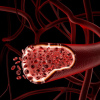
Currently, "frozen shoulder" is a collective term used to describe a clinical syndrome in which a patient experiences a sharp limitation in both passive and active movements of the shoulder joint, accompanied by pain.
❗️ Common causes of frozen shoulder include:
- Shoulder joint injury complicated by a rotator cuff tear
- Microtraumatic damage to the capsule due to cyclical loads
- Acromial-tubercular impingement syndrome
- Diseases such as rheumatoid arthritis and diabetic arthropathy
The good news is that conservative treatment is successful in 90% of patients with frozen shoulder. Only a few require surgical intervention, such as manipulation under anesthesia or arthroscopic capsule release.
It's important not to give up on conservative treatment attempts and immediately resort to surgical treatment.
Along with NSAIDs and steroids, physical therapy remains one of the cornerstones in treating frozen shoulder syndrome. Physical therapy includes "pain-relieving," "mobilizing," and "strengthening" components.
✅ Therapeutic exercises combined with NSAIDs or steroid injections are more effective in relieving symptoms than therapeutic exercises alone.
When treating this condition, stretching exercises in four directions and core muscle strengthening have shown high effectiveness. Core muscles are the deep muscles that run along the spine and provide stability.
#FrozenShoulder #PhysicalTherapy #HealthTips #PainRelief
Write a review
Required fields are marked with *
Categories
- Therapy (31)
- GP (23)
- News (21)
- Endocrinology (8)
- Cardiology (7)
- Ortopedics (4)
- Dermatology (3)
- urology (1)
- Check-up (1)
- Ultrasound (1)
Articles
Archive
- November 2025 (6)
- October 2025 (6)
- September 2025 (6)
- August 2025 (7)
- July 2025 (4)
- June 2025 (11)
- May 2025 (9)
- April 2025 (5)
- March 2025 (3)
- February 2025 (2)
Categories
- Therapy (31)
- GP (23)
- News (21)
- Endocrinology (8)
- Cardiology (7)
- Ortopedics (4)
- Dermatology (3)
- urology (1)
- Check-up (1)
- Ultrasound (1)



_100x100_ea6.jpg)




_60x60_ebd.jpg)
Comments (0)